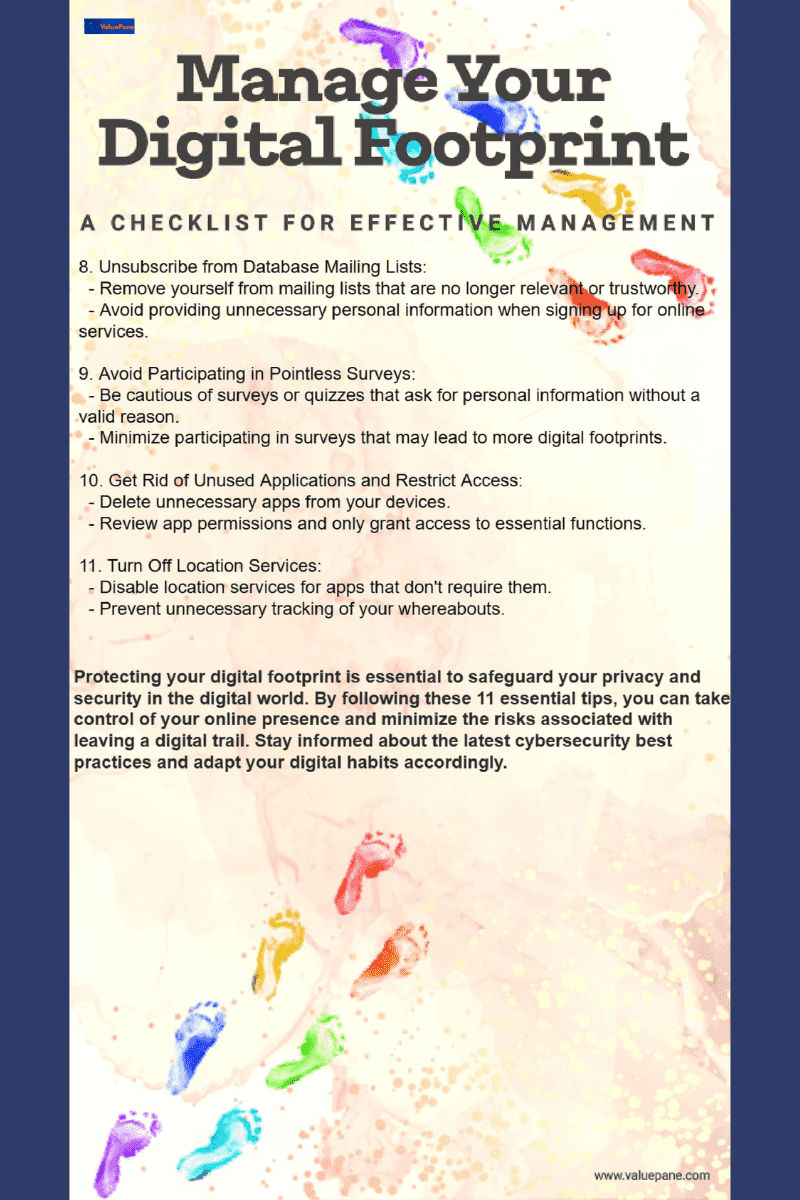Most of us know that we leave behind information every time we go online- Right? Everything we do online like browsing the web, shopping, streaming, posting, or emailing, creates a digital footprint that can reveal a lot about us and our online activities.
Our digital footprint is the collection of data that traces our online presence and behavior, such as our personal information, preferences, opinions, interests, habits, etc. It can be used by various parties, such as advertisers, hackers, employers, governments, etc., for different purposes, such as personalization, convenience, socialization, reputation, opportunities, etc.
But while having a digital footprint can provide you with some benefits, it can also expose you to some risks and challenges. In the age of artificial intelligence (AI), your digital footprint can be used against you in ways that you may not even imagine.
AI is the technology that enables machines to perform tasks that normally require human intelligence, such as learning, reasoning, decision making, etc. AI can be used to repeat or clone anything digital such as deepfakes, synthetic media, generative adversarial networks (GANs), etc. AI can also be used to analyze your digital footprint and create fake identities, impersonate people, and commit fraud.
According to a report by Bitdefender , 57% of the community have over 12 data entry points exposed online, and an alarming 16% have over 50 instances of personal info up for grabs in the digital world. This means that your digital footprint can be exploited by cybercriminals to launch identity theft, phishing attacks, cyberstalking, online harassment, discrimination, etc.
The costs and consequences of having an insecure digital footprint can be devastating for individuals and businesses alike. Even while researching for this post, I got a message from Google about one of my passwords being compromised.
So how can you and me secure our digital footprint in 2023 and beyond in the age of AI? How can we protect our online privacy and security while enjoying the advantages of having a digital presence?
In this blog post, we will explore the risks and benefits of having a digital footprint and how to manage it effectively. We will also share some tips and best practices on how to secure your digital footprint in 2023 and beyond in the age of AI.

Table of Contents
The Risks of having a Digital Footprint
As mentioned earlier your digital footprint can expose your personal data, online activities, preferences, opinions, etc. to various parties who may have different intentions and agendas. Some of these parties may use your digital footprint for legitimate purposes, such as providing you with relevant products or services, enhancing your user experience, or offering you opportunities.
However, some of these parties may use your digital footprint for malicious purposes, such as stealing your identity or money, spying on your online behavior or location, harassing or blackmailing you online or offline, or discriminating against you based on your online profile.
Some examples of how your digital footprint can be used against you:
- Identity theft: Cybercriminals can use your personal information (such as name, date of birth, social security number, address, phone number, email address, etc.) to open bank accounts, apply for loans or credit cards, file tax returns, or commit other fraudulent activities in your name.
- Phishing attacks: Cybercriminals can use your email address or phone number to send you fake messages or calls that appear to be from legitimate sources (such as banks, government agencies, or online platforms) and trick you into revealing your passwords, account numbers, or other sensitive information.
- Cyberstalking: Cybercriminals can use your online activities (such as browsing history, search queries, social media posts, etc.) to track your interests, habits, location, or schedule and stalk you online or offline.
- Online harassment: Cybercriminals can use your online presence (such as photos, videos, comments, reviews, etc.) to harass you online by sending you abusive messages, posting negative or false information about you, or creating fake profiles or content to damage your reputation.
- Discrimination: Cybercriminals can use your online profile (such as age, gender, race, religion, political views, etc.) to discriminate against you based on their biases or prejudices. For example, they may deny you a job opportunity, a loan application, or a service based on your online profile.
The costs and consequences of having an insecure digital footprint can be significant for individuals and businesses alike. According to a report by IBM , the average cost of a data breach in 2022 was $4.24 million globally and $9.05 million in the US. The report also found that human error was the cause of 19% of data breaches and that the average time to identify and contain a data breach was 287 days. Moreover, according to a survey by Norton , 33% of global consumers have experienced identity theft and 10% have experienced it more than once. The survey also found that identity theft victims spent an average of 81 hours and $358 to resolve their cases.
The Benefits of having a Digital Footprint
While having a digital footprint can expose you to some risks and challenges, it can also provide you with some advantages and opportunities. Your digital footprint can help you access and enjoy various online services and platforms that can enhance your personal and professional life. Your digital footprint can also help you express yourself and connect with others who share your interests, values, or goals.
Some examples of how your digital footprint can be used to your advantage:
- Online shopping: Your digital footprint can help you find and buy products or services that suit your needs, preferences, or budget. Online platforms can use your browsing history, search queries, or purchase history to recommend you relevant items, offer you discounts or coupons, or provide you with customer support.
- Entertainment: Your digital footprint can help you access and enjoy various online entertainment options, such as streaming movies, music, games, podcasts, etc. Online platforms can use your viewing history, ratings, or reviews to suggest you content that matches your taste, mood, or genre.
- Education: Your digital footprint can help you access and benefit from various online education resources, such as courses, tutorials, webinars, podcasts, etc. Online platforms can use your learning history, progress, or feedback to personalize your learning experience, provide you with guidance or support, or award you with certificates or badges.
- Networking: Your digital footprint can help you connect and communicate with other people who share your interests, values, or goals. Online platforms can use your social media posts, comments, likes, or shares to introduce you to potential friends, partners, or collaborators.
- Career development: Your digital footprint can help you showcase your skills, achievements, or personality. Online platforms can use your resume, portfolio, blog, or social media profiles to attract potential employers, clients, or investors.
The benefits and outcomes of having a secure digital footprint can be substantial for individuals and businesses alike. According to a report by McKinsey , the global e-commerce market grew by 25% in 2022 and reached $4.28 trillion in sales. The report also found that online education platforms saw a 250% increase in enrolments in 2022 and that online entertainment platforms saw a 40% increase in subscriptions in 2022.
Moreover, according to a report by LinkedIn , 87% of recruiters use LinkedIn to find candidates and 122 million people received an interview through LinkedIn in 2022.

How to Manage your Digital Footprint Effectively
To secure your digital footprint in 2023 and beyond in the age of AI, you need to be proactive and responsible for your online privacy and security. You need to be aware of what data you are sharing online and how it can be used by various parties.
You also need to follow some tips and best practices to protect your personal data, avoid oversharing on social media, and verify the sources and authenticity of online information.
Here are some tips and best practices on how to secure your digital footprint in 2023 and beyond in the age of AI:
- Review your online presence regularly and delete unwanted accounts and content: You should periodically check your online presence and remove any accounts or content that you no longer use or need. You should also delete any information that is outdated, inaccurate, or irrelevant. This will help you reduce your digital footprint and minimize the exposure of your personal data.
- Protect your personal data by using encryption tools, VPNs, password managers, etc.: You should use encryption tools to encrypt your data before sending it online or storing it on cloud services. Encryption tools will make your data unreadable to anyone who does not have the key to decrypt it. You should also use VPNs (virtual private networks) to hide your IP address and location when browsing the web or accessing online services. VPNs will create a secure tunnel between your device and the server you are connecting to. You should also use password managers to create and store strong passwords for your online accounts. Password managers will generate random passwords that are hard to guess or crack and store them securely on an encrypted database.
- Avoid oversharing on social media and adjusting your privacy settings: You should be careful about what you share on social media platforms and who you share it with. You should avoid posting sensitive information such as your full name, date of birth, address, phone number, email address, etc. You should also avoid posting information that could reveal your location, schedule, or plans. You should also adjust your privacy settings on each platform to control who can see your posts, comments, likes, or shares. You should also review the permissions that each platform has to access your data, such as contacts, photos, location, etc.
- Be aware of how AI can be used to repeat or clone anything digital such as deepfakes, synthetic media, generative adversarial networks (GANs), etc. and verify the sources and authenticity of online information: You should be aware of how AI can be used to create fake or manipulated digital content that can deceive or mislead you. For example, deepfakes are videos or images that use AI to replace the face or voice of a person with another person’s. Synthetic media are videos or images that use AI to generate realistic but fictional content. Generative adversarial networks (GANs) are AI models that use two competing neural networks to create realistic but fake content. You should also verify the sources and authenticity of online information before trusting or sharing it. You should check the credibility and reputation of the source, the date and context of the information, and the evidence and logic of the argument. You should also use tools such as reverse image search, fact-checking websites, or AI detectors to spot fake or manipulated content.
Video Resource
The above is a video about a Deepfake from Exonet
Download Resource
Download Your Digital Footprint Checklist


Conclusion
In this blog post, we have explored the risks and benefits of having a digital footprint and how to manage it effectively. We have also shared some tips and best practices on how to secure your digital footprint in 2023 and beyond in the age of AI. We hope that you have learned something valuable from this post and that you will take action to protect your online privacy and security in the age of AI.
Having a digital footprint is inevitable in today’s digital world, but it does not have to be a liability. If you are proactive and responsible for your online presence and behavior, you can enjoy the advantages of having a digital presence while minimizing the exposure of your personal data. You can also leverage the power of AI to enhance your online experience while being aware of its potential threats and challenges.
You should review your online presence regularly and delete unwanted accounts and content, protect your personal data by using encryption tools, VPNs, password managers, etc.
Avoid oversharing on social media and adjusting your privacy settings, be aware of how AI can be used to repeat or clone anything digital such as deepfakes, synthetic media, generative adversarial networks (GANs), etc. and verify the sources and authenticity of online information.
Thank you for reading and we hope to see you again soon!😊





There is no question in my mind that this website will quickly become well-known due to the high-quality articles that it publishes as soon as its administrator begins working.
Great information shared.. really enjoyed reading this post thank you author for sharing this post .. appreciated
I rarely read blog posts, but this one compelled me to. Your writing style is amazing. Thanks for a great post.